Sun activity for April 30, 2023: Solar flare chances increase
Sunspot region AR3288 continues to attract our attention. One part has retained a delta magnetic classification. And that means it still has a potential for significant flare activity. But, overall, sun activity hasn’t yet moved above the low level. That’s because only C flares have been observed. But the flaring chances have noticeably increased for C, M, and X flares. The region next to AR3288, region AR3285, is also producing C flares seemingly in concert with its neighbor. We will continue to watch both areas.
Last 24 hours: AR3288 and AR3285 produced all but one of the 11 C flares in the last 24 hours. The largest event was a C7.4 from AR3288 at 8:37 UTC on April 30, 2023. The sun has six labeled active regions today.
Sun activity for April 29, 2023: A new potential for X flares
Yesterday’s M flare producer, AR3288, has developed a delta region. This indicates that it harbors the potential for more M flares, and possibly X flares. So this active region is the one to watch at the moment.
Last 24 hours: AR3288 produced most of the 19 C flares observed over the past day (11 UTC April 28 to 11 UTC April 29). That’s more than yesterday’s total, so flaring production is already up. But the lack of any M flares means that – overall – sun activity has reduced from moderate to low. We saw 19 C flares over the past day. The largest was a C7.2 flare from sunspot AR3288 at 21:45 UTC on April 28. We saw a C6.8 flare from AR3289 at 16 UTC on April 28. Both of these flares had associated filament eruptions. The sun has six labeled active regions today.
Sun activity for April 28, 2023: Double solar flares, plus a coming storm
The number of solar flares produced over the last 24 hours was double the previous day’s total. One of these 16 flares was an M1.8, produced by AR3288 near the beginning of our observation period (11 UTC April 27 to 11 UTC April 28). And so the sun has increased to moderate activity, as we await a possible G1 (minor) geomagnetic storm over Earth today. Over the past day we have seen active geomagnetic conditions (Kp = 4) produced by fast solar wind from a coronal hole. On top of this, we’re expecting the possible arrival of the CME that was hurled into space on April 24. Only a glancing blow is expected. In fact, there’s a chance it has already missed us. If it does still brush by Earth, auroras might be witnessed as far south as northern states in the U.S., over the coming day. Stay tuned.
Last 24 hours: Sun activity has increased to moderate levels, with flare productivity picking up during the past day. We observed 15 C flares and one M flare. It was sunspot AR3288 that fired off an M1.8 flare at 11:14 UTC on April 27. The explosion produced an R1 (minor) radio blackout that affected an area over Africa. AR3288 was also the leading flare producer of the past day, with 8 C flares, plus the M flare. The sun has seven labeled active regions, including a newcomer numbered AR3289.

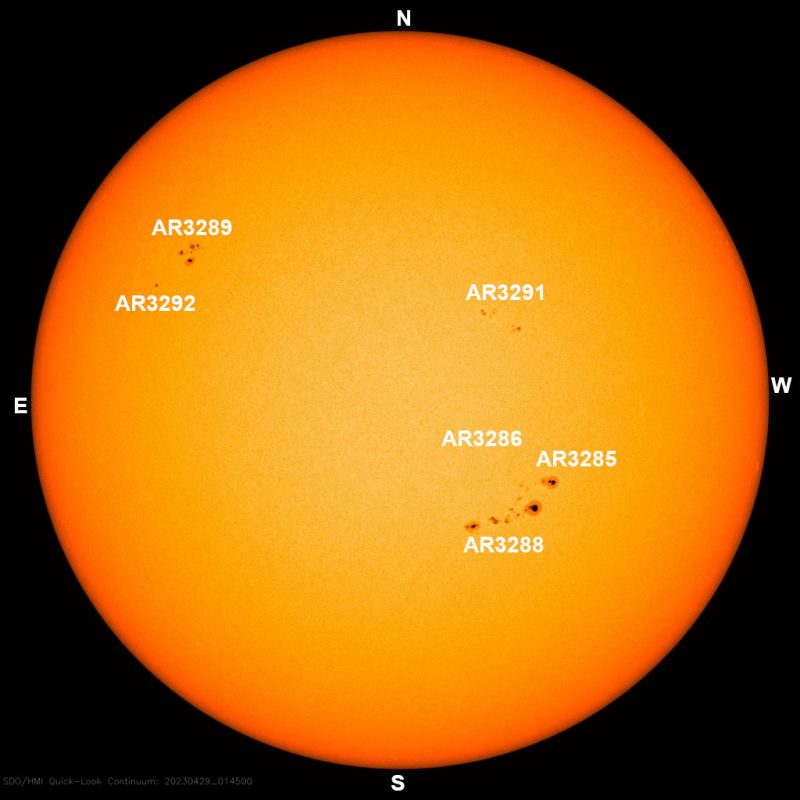
Sun activity for April 27, 2023: CME impact expected today
Spaceweather forecasters are expecting the April 24 coronal mass ejection (CME) to brush past Earth today, producing up to a G1 (minor) geomagnetic storm. Good luck aurora watchers! A filament erupted from the east-northeast side of the solar disk, producing a CME that’s headed mostly away from Earth. We await any further analysis to see if it might brush past Earth in a few days. Meanwhile, the sun is sporting three coronal holes, including two Earth-directed ones currently rattling our magnetic field with fast solar wind. Stay tuned.
Last 24 hours: Sun activity remains low. That is, the sunspot regions peppering the solar disk are not very active. But that could change at any time. There were eight C flares produced between 11 UTC yesterday and 11 UTC today. The largest was a C3.1 at 00:41 UTC on April 27 by AR3289. Today the sun has six labeled active regions.
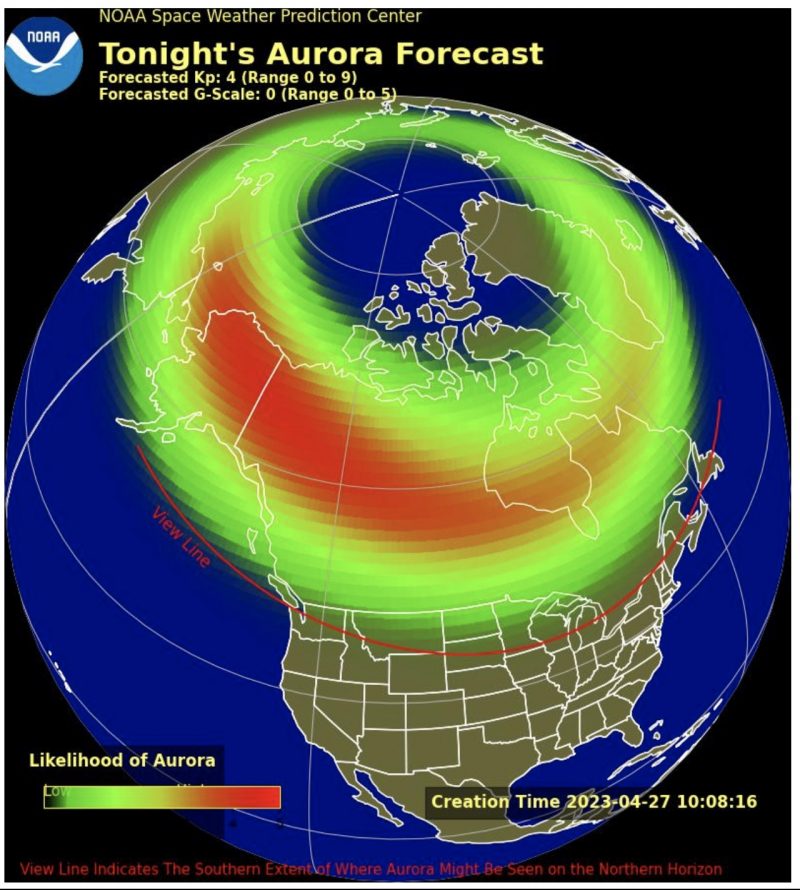
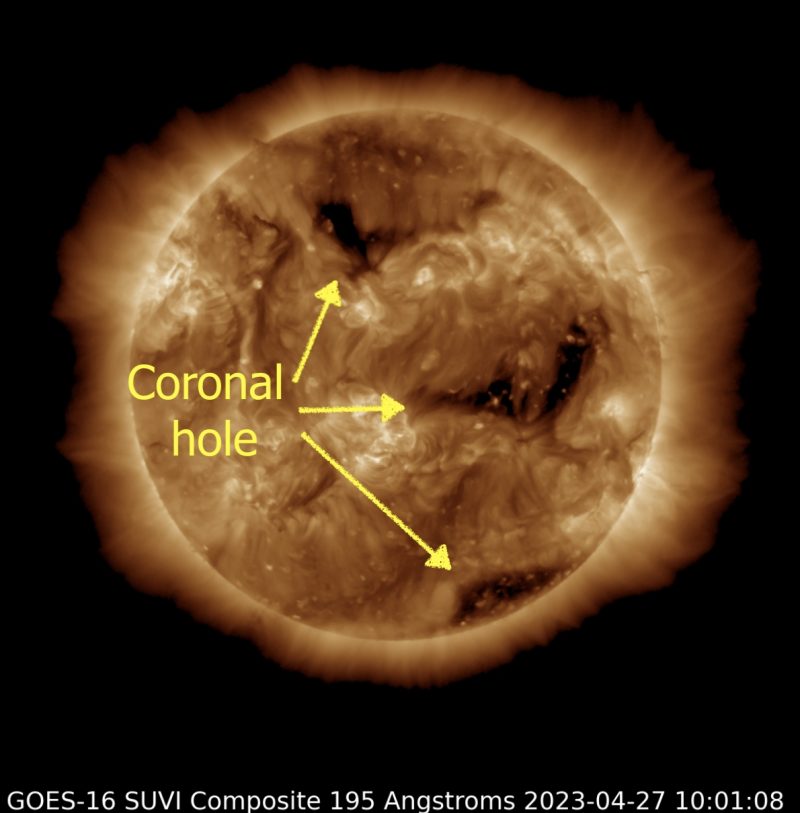
Sun activity for April 26, 2023: Action coming from the northeast
Action is arriving on the sun’s northeast limb (edge). A newly-labeled active region has just come into view on this limb: meet AR3289! And there seems to be activity following closely behind it. We saw a huge prominence on the far side of the sun, coming from AR3289’s vicinity. The blast occurred at around 7 UTC on April 26. It fired off a coronal mass ejection (CME), but the CME isn’t aimed our way. Turning to the solar northwest, we spied a long-lasting tornado-like prominence, which ended with an ejection of plasma. And on the southwest quadrant, a filament eruption produced a CME which, again, is not Earth-oriented. Stay tuned.
Last 24 hours: Sun activity remains low. There were only two weak C1.1 flares produced between 11 UTC yesterday and 11 UTC today. The first was fired at 19:12 UTC on April 25 by an unnumbered active region in the northeast, and the second at 3:55 UTC on April 26 by AR3285. There are two newcomer active regions on the side of the sun we see. AR3288 emerged from nowhere on the southeast quadrant, while AR3289 on the northeast limb (edge) had been announcing its entrance for several days. AR3286 has disappeared. And AR3282 and AR3284 have rotated out of view in the west. So today the sun bears five labeled active regions. All of these are stable.
Sun activity for April 25, 2023: Storm over, but more action coming
The G4 (severe) geomagnetic storm is over, with Earth’s magnetic field returning to quiet levels. But the area on our sun that produced the storm has been active again. An exploding filament has been observed in the vicinity of a large coronal hole in the southwest, the same location that produced the full-halo event of April 21. The explosion happened at around 14 UTC on April 24. A CME was registered by the LASCO C3 imager aboard NASA’s SOHO spacecraft, as seen in our top animation (alongside SDO imagery). Preliminary analysis suggests that a glancing blow from this CME might reach us late on April 27. That means more auroras are expected, but at a lower level than what we just saw. Plus, it looks like more action is on its way: check out the imagery below of a fiery east limb (edge) with prominences all over, now rotating into view. And there are currently two coronal holes on the Earth-side of our star. One is located in the southwest quadrant close to the limb (edge), and the second is located where the central meridian and the equator meet – this one helped provide the spectacular auroras of the last few days! So more action is coming – stay tuned.
Last 24 hours: Sun activity remains at low levels. There were seven C flares produced during the past day (11 UTC yesterday to 11 UTC today). A C2.8 flare was the largest of the day, produced by active region AR3282 at 13:05 UTC on April 24. There are two newcomers on the Earth-viewed side of the sun: AR3286, which emerged from nowhere on the southeast quadrant, and AR3287 on the southeast limb (edge), brought into view by the sun’s rotation. The sun today bears six labeled active regions, all of which are stable.
Sun activity for April 24, 2023: Big night for auroras last night!
On April 21, 2023, we had a full-halo event, suggesting a coronal mass ejection (CME) on its way to Earth. It arrived at Earth late yesterday (April 23), and its effects combined with solar wind from a coronal hole to give us a great night for auroras! Geomagnetic storm levels reached G4 (severe); that’s just one step below the strongest ranking on the NOAA scale (G5, or extreme). Earth’s magnetic field has been disturbed with a Kp = 8 since last night (threshold reached at 18:49 UTC). And geomagnetic storming is expected to continue, albeit at less-strong levels, for the next few days. At the time of this writing (11 UTC on April 24), the geomagnetic index remains at a G3 (strong) level. Note that – exactly a month ago on March 24, 2023 – geomagnetic storming reached a similar G4 (severe) level. Last night, the same as a month ago, auroral displays have been reported in the Northern Hemisphere as far south as northern California, in U.S. and northern parts of the U.K. and Denmark in Europe. This morning, auroras are being reported from Utah and Colorado. Salt Lake City has even reported red auroral displays. What joy, with glorious auroras everywhere! Please share your photos with EarthSky’s community.
Last 24 hours: Sun activity continues at low levels. Only two C flares were produced during the past day (11 UTC yesterday to 11 UTC today), a C1.1 at 17:11 UTC and a C1.0 at 20:38 UTC. Both flares were blasted by active sunspot region AR3282. At the same time, the sun’s rotation is bringing more action to the Earth-viewed solar disk. Its east limb (edge), the side now rotating into view, is exceptionally fiery, with long-lasting prominences. See the animation below. The sun today bears six labeled active regions, all of which are stable.

Sun activity for April 23, 2023: CME arrival soon, G2 storms anticipated
It’s now confirmed that the coronal mass ejection (CME) hurled to space during the full-halo event of April 21, 2023, will arrive at Earth on late April 23, or early 24. NOAA has issued an alert for CME arrival. Geomagnetic storms up to G2 (moderate) are anticipated. Earth will be receiving this CME in addition to high-speed solar wind from a coronal hole. All in all, you can anticipate good conditions for auroral displays. Meanwhile, turning our heads back to the sun, we have seen an active east limb (edge). It seems more action will soon show itself on the Earth-facing side of our star. That side – the east limb (edge) – has been full of exploding ejecta, jets and long-lasting prominences. Specialists can tell much activity is going on in that area. And the sun’s rotation will bring it into view in the coming days. There’s also now a new large coronal hole that emerged on the sun’s east hemisphere, close to the equator. Aurora watchers, polish your cameras lenses and have your equipment at hand!
Last 24 hours: Sun activity is back to low levels. There was a recession in flaring with only three C flares produced during the past day (11 UTC yesterday to 11 UTC today). The largest was a C2.2 flare that blasted at 6:40 UTC on April 23, 2023 by active region AR3279. The biggest sunspot, AR3282, is now closed to the west on the solar horizon. Shortly, it will move out of sight as it gets carried by the sun’s rotation. The sun today bears six labeled active regions and all show a simple beta magnetic configuration. These spots are either stable or in decay.
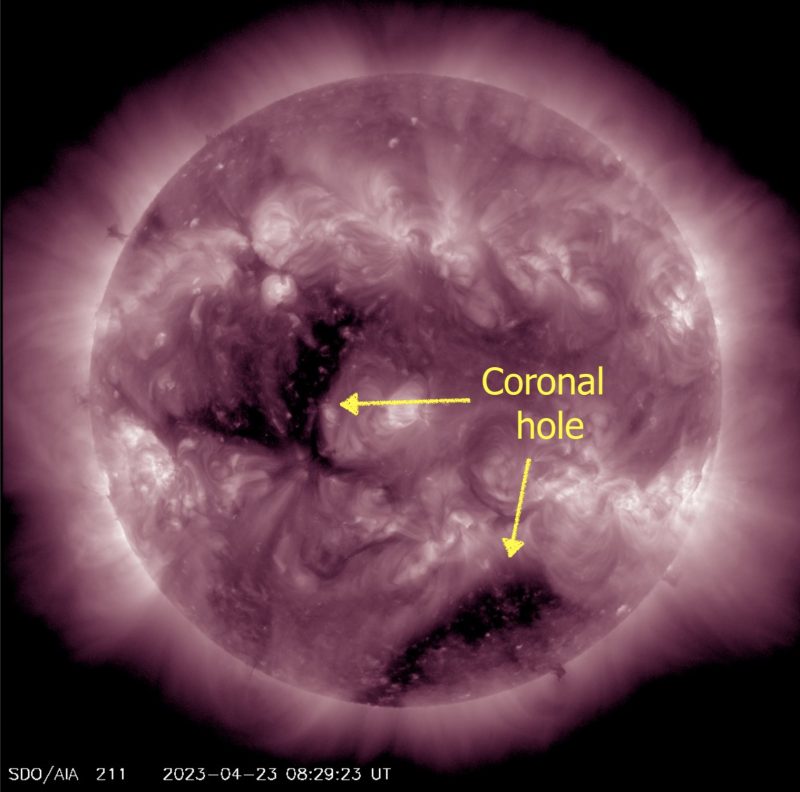

Sun activity for April 22, 2023: Strong full-halo filament explosion
A strong filament explosion in the sun’s southern hemisphere caused a full-halo coronal mass ejection (CME) late yesterday. In other words, the blast sent plasma into space that’s now coming Earth’s way. CMEs aimed at Earth are called halo events because of the way they appear in images of the sun. On images of an Earth-directed CME, you’ll see an apparent expanding cloud that can wholly envelop the sun, forming an apparent halo around our star. Yesterday’s halo event is associated with a M1.77 flare by sunspot active region AR3283. The flare happened at 18:12 UTC on April 21, 2023. Ultraviolet imagery shows an unstable filament exploding over a twisting magnetic structure, seeking its way to reconnect with the sun, creating an almost full circle before it funnels back into the sun. LASCO C2/ C3 imagery showed a full-halo CME signature shortly after the explosion. Type II and IV solar radio emissions were associated with the event. While the CME is coming our way, imagery and analysis are undergoing to determine a more precise transit time to Earth. After all, we are 93 million miles (150 million km) from our star. As you can see on our top animation, the event occurred in the vicinity of a large coronal hole in the sun’s southern hemisphere. A combined high-speed solar wind from this coronal hole along with the CME of this explosion might bring auroral display to Earth in the coming days.
Last 24 hours: Sun activity is now moderate, with the production of the above-mentioned M1.77 flare by AR3283. Flaring production reduced during the period (11 UTC yesterday to 11 UTC today) to four flares only, one M and three Cs. The largest was the much-discussed M1.77 flare. There’s a newcomer sunspot on the sun’s southeast limb (edge), now labeled AR3285. AR3282 continues to be the biggest in extent on the Earth-viewed solar disk. But it remained mostly quiet throughout the past day. The sun today bears six labeled active regions.
Sun activity for April 21, 2023: Dramatic end for eclipse prominence
Did you see the beautiful cone-like prominence on the north of the sun during yesterday’s hybrid solar eclipse? It’s gone today. It departed in an enormous explosion, shooting solar plasma into space (see the top animation for this dramatic moment). Plasma isn’t normal gas. It’s a 4th state of matter consisting of particles and magnetic fields, which interacts with the outer space environment of our solar system to produce space weather. One mechanism for this interaction is the phenomenon of coronal mass ejections (CMEs) that blast from the sun. And this prominence did produce a CME. You can see it in the LASCO-C2 imagery below. CMEs can produce both beautiful auroras (which many love and watch for) as well as destruction to earthly technologies (causing power and communication blackouts). For this prominence’s CME, neither will occur, because the prominence was near the sun’s north pole, so its ejecta isn’t Earth-directed.
Last 24 hours: Sun activity remains low. 12 C class flares were produced over the past day (11 UTC yesterday to 11 UTC today). The largest was a C3.3 flare, produced at 16:23 UTC on April 20 by an as-yet-unnumbered active region in the southeast. This region was the lead flare producer, with five C flares. AR3282 continues to be the biggest in extent on the Earth-viewed solar disk. The sun bears today six labeled active regions. No newcomers today.

Sun activity for April 20, 2023: Huge sunspot region AR3282
We had a glorious solar eclipse earlier today. Did you see it? Many did in northwestern Australia, Timor-Leste or Indonesia and/or via live-stream. View eclipse pics from our community, here. See the giant sunspot region in the photo above, by Vermont Coronel Jr in the Philippines? That’s AR3282 was the lead flare producer with six C explosions. Over the past day, we also saw exploding filaments release coronal mass ejections (CMEs), none of which are Earth-bound, and a very active solar west with long lasting prominences. Maybe you saw some of those prominences during the eclipse, when the moon covered the sun completely. Overall activity on the sun was low over the past day. But flare production increased from the day before. Also, another aurora alert for tonight! Details below.
Last 24 hours: Sun activity is low. 21 C class flares were produced during the past day (11 UTC yesterday to 11 UTC today). The largest was a C3.6 flare that came from by sunspot region AR3281 at 9:22 UTC on April 20, 2023. AR3282 was the lead flare producer with six C explosions. AR3281 followed closely with five C flares. The sun bears today six labeled active regions.
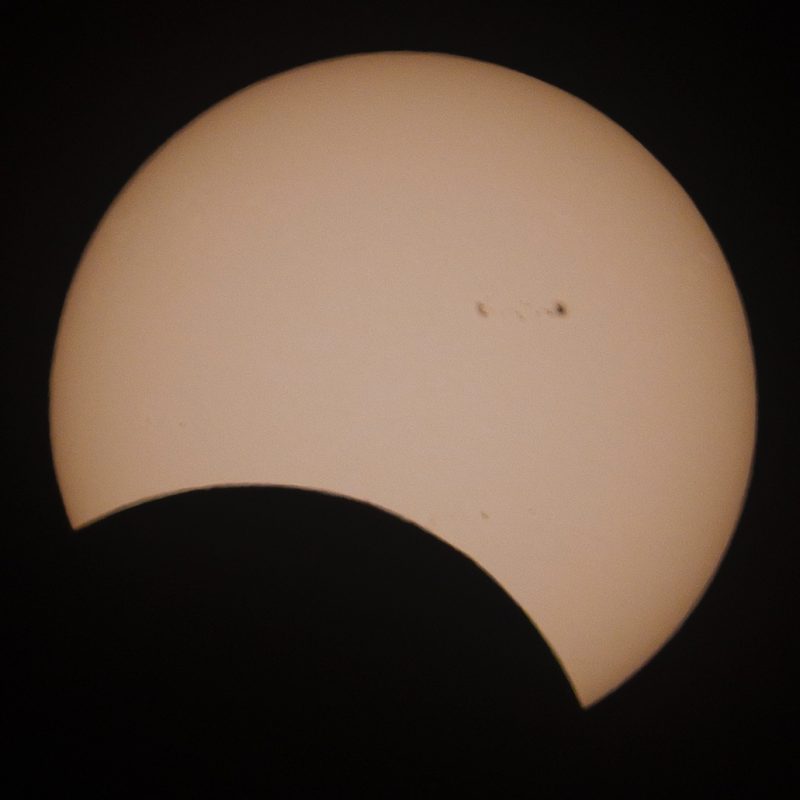
Sun activity for April 19, 2023: Geomagnetic storm possible today
G1 (minor) geomagnetic storming is predicted for today through April 20 and 21, 2023. The reason is two coronal mass ejections (CMEs) have set to reach Earth over today and tomorrow. That means … auroras! The first CME left the sun on April 15, and might arrive early today, April 19. Any geomagnetic disturbance will be extended through the rest of the day. The second CME was detected by GOES-16 SUVI imagery on April 16 (see animation below) and might arrive on April 20, with effects possibly continuing through April 21. NOAA is forecasting auroral displays for tonight and tomorrow night, with geomagnetic storms predicted up to G1 (minor). Good luck, aurora chasers! By the way, today is an eclipse day. It falls on April 19 in the Americas (but it’s not visible from here) and April 20 across the International Date Line. The eclipse will be visible in Australia, Timor-Leste and Indonesia. Get the full details here.
Last 24 hours: Sun activity remains low. Between 11 UTC yesterday and 11 UTC today, our star produced a total of 16 C flares. The largest was a C4.8, blasted by AR3280. After being carried out of sight yesterday by the sun’s rotation, this active region is now located behind the sun’s southwest limb (edge). The explosion occurred at 15:29 UTC on April 18. AR3280 was the day’s leading producer with five C flares. The Earth-viewed side of our sun is currently populated with seven labeled sunspots. Most of the seven sunspots show decay. The active regions that yesterday showed a beta-gamma configuration – AR3281 and AR3282 – have reduced to beta. AR3282 continues to be the biggest in extent.
Sun activity for April 18, 2023: Farewell, AR3280. Welcome, AR3284
Today we say farewell to sunspot region AR3280. This spot had emerged abruptly on the southwest quadrant on April 14. It grew rapidly into a beta-gamma magnetic configuration, creating expectations for possible increased flaring. During its short life on the Earth-facing side of our star, it was the lead flare producer for a couple of days. But it produced only C flares. Now AR3280 has rotated out of sight on the sun’s southwest limb (edge). Meanwhile, we welcome AR3284 on the sun’s east limb: the side just now rotating into view. This sunspot was the producer of yesterday’s largest flare, a C9.1 flare (near the boundaries of the Ms) while still on the sun’s far side. Now AR3284 is here! Let’s see what it brings.
Last 24 hours: Sun activity is low, with C flares only. From 11 UTC yesterday to 11 UTC today, the sun produced 13 C class flares. The largest was a C6.9, produced by AR3283. It occurred at 14:31 UTC on April 17. AR3283 is our lead flaring producer of the day with six flares during the period. The sun currently bears eight labeled sunspots on its Earth-facing side. There are two sunspots showing a beta-gamma configuration: AR3281 and AR3282. The biggest in extent is AR3282.
Sun activity for April 17, 2023: A blast from the east
Sun activity continues firing away at low levels. But we did see an explosion that almost reached the M flare threshold. It was a C9.1 flare that blasted at 17:44 UTC on April 16, 2023. It came from an incoming active region on the sun’s northeast limb (edge). The sunspot will not receive a label until it comes completely into Earth’s view. Before experts can give a sunspot a label and assign a number to the active region, Earth needs to be in complete view of the sunspot. Still, the C9.1 flare was impressive. And a strong prominence followed it, also from the vicinity of this sunspot. Meanwhile, regions AR3281 and AR3282 showed minor growth while keeping their beta-gamma magnetic configurations. The rest of the sunspots on the Earth-viewed side of the solar circle remained either stable or are showing signs of decay.
Last 24 hours: Sun activity continues to be low. There were 13 C flares during this period. As explained above, the largest was a C9.1 flare that occurred at 17:44 UTC on April 16, 2023, on the northeast limb (edge) by an unnumbered active sunspot region. The lead flare producer of the day was AR3280, which blasted 5 C class flares. There is also a new kid on the block, AR3283, which emerged on the southeast quadrant. The Earth-facing side of our star today bears nine labeled active regions.
Sun activity for April 16, 2023: Filaments and other fiery details
Sun activity returned to low levels during the past day, with only C flares on the Earth-viewed side of our star. But take a look at our top animation for lots of mesmerizing action. Find a coronal mass ejection (CME) on the northwest quadrant and an exploding filament on the northeast, occurring almost at the same time. Beautiful ejecta can be seen on the southeast quadrant. And, on the northwest, you can see a giant filament explosion. Finally – also in the top animation – there’s a jet-prominence on the southwest. It can be noted it comes from the far side. Can’t see it? Check out the closeup animation below. Keep looking at the animation above. You might find more details of your own to enjoy. All in all, fiery activity all around our side of the sun, is still considered low-level activity!
Last 24 hours: In all, over the past day (between 11 UTC yesterday and 11 UTC today), there were 18 C flares. That was the total flaring produced during the period. The largest was a C5.4 flare blasted at 17:23 UTC on April 15, 2023 by sunspot AR3280. Two sunspot regions shared first place on flare productivity, AR3280 and AR3281, with six C flares each. Both now show a beta-gamma configuration, indicating (possibly) a potential for more flaring. AR3282 reduced its flare production of yesterday (when it had high magnetic complexity, two M flares and 11 Cs) to only three Cs during the past day. The Earth-side of our star today bears eight labeled active regions.
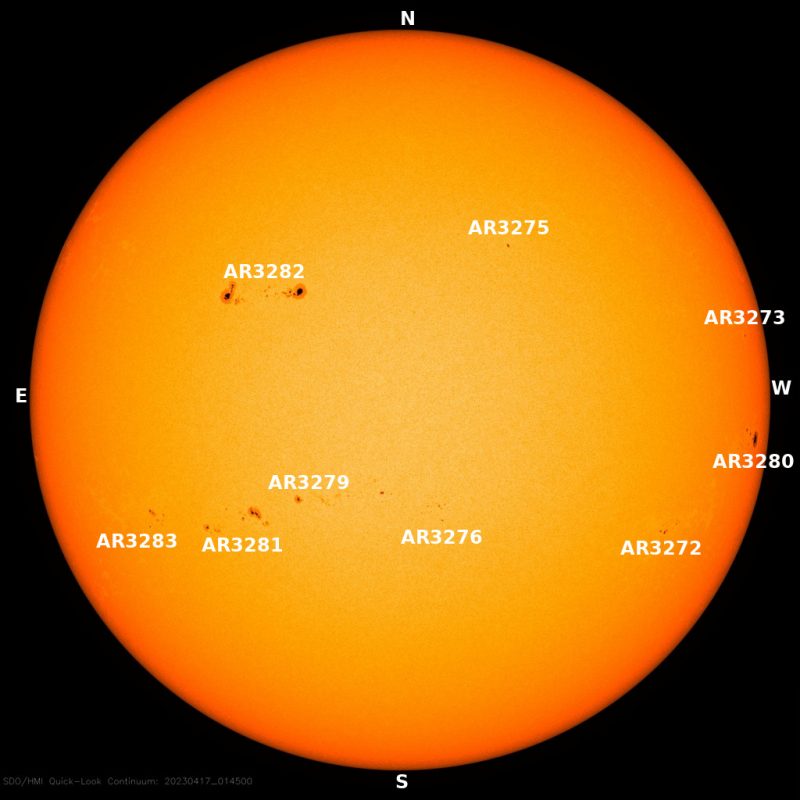
Sun activity for April 15, 2023: Newcomer sunspot AR3282 blasts 2 M flares
After several days of only C flares, sun activity has now reached moderate levels, with two M flares from AR3282 in the past day. This newcomer sunspot released an M1.1 at 16:18 UTC on April 14. And it released an M1.5 at 23:27 UTC on April 14. The two were minor impulsive flares (impulsivity refers to how quickly the initial energy release occurs). The most recent M flare before yesterday was on April 11. AR3282 is also today’s largest sunspot region on the Earth-viewed side of our star. It’s currently showing a beta magnetic configuration. Meanwhile, AR3280 – on the southwest solar quadrant – is the region currently showing the highest magnetic complexity of the day (beta-gamma). A more complex magnetic structure suggests a greater likelihood for solar flares. But you never know. Meanwhile, take a last look, in our animation below, at the 2023 passage of Jupiter beyond the sun, as seen by the LASCO C2 imager on NASA’s SOHO spacecraft. The image is from yesterday, April 14. Jupiter reached superior conjunction on April 11. It has now gone out of the field of the view of SOHO’s instruments, but it’s heading for a return to our eastern predawn sky in the weeks ahead. Visit EarthSky’s night sky guide.
Last 24 hours: Sun activity is moderate. There were 19 C flares and two M flares produced between 11 UTC yesterday and 11 UTC today. The largest was an M1.5 flare, blasted by sunspot AR3282 at 23:27 UTC on April 14. AR3282 was the leading producer with 11 flares, the two M flares included. After each M flare, corresponding R1 (minor) radio blackouts were registered. The first affected an area over the east Caribbean and the second over the Pacific Ocean, north of New Guinea. There are nine labeled active regions on the Earth-side of our sun today. Is sun activity picking up? We’ll see.
Sun activity for April 14, 2023: Quiet, but the sunspots keep coming
A couple of days ago, the sun showed only two sunspots on its Earth-viewed side. Now our star – as seen from Earth – has nine sunspots! Here’s a breakdown of the sunspots today:
AR3272 in the SW
AR3273 in the NW
AR3275 in the NE
AR3276 in the SE
AR3278 in the NW
AR3279 in the SE
AR3280 in the SW
AR3281 in the SE
AR3282 in the NE
Last 24 hours: Sun activity is still low. There were 10 C flares produced between 11 UTC yesterday and 11 UTC today. The largest was a C8.5, blasted by sunspot AR3272 at 11:07 UTC on April 13. AR3281 was the leading producer with four flares out of the 10. We have three newcomer sunspots today. AR3280 emerged from the sun’s southwest quadrant. AR3281 came into view on the southeast limb (edge). And AR3282 appeared on the northeast limb. We saw a jet blasted at around 16 UTC on April 13. It came from a region on the far side of our sun, which the sun’s rotation will soon carry into our view. See the animation below. With nine active regions, will sun activity pick up? We’ll see.
Sun activity for April 13, 2023: The splitting of AR3276, and solar deja vu
Sun activity is low. But what happened to sunspot region AR3276? Turns out it split into two, much as AR3270 did on April 4. Solar deja vu! Since before it rotated into view on the sun’s southeast limb (edge) a few days ago, AR3276 has been the source of experts’ expectations. For one thing, it blasted an M flare plus a number of Cs, even before it was fully visible. Then, shortly after it rotated enough into view enough to get a label, it showed a beta configuration. There were hints it could be spreading out. Finally, early today, AR3270 was seen to have split into two separate sunspots. The “new” active region that emerged from AR3276’s vicinity was given a separate label: AR3279. And the newly numbered AR3279 thereby became the leader in flare production over the past day, with 13 C flares.
Last 24 hours: Sun activity is low, with only C flares. But flare productivity picked up over the past day, in contrast to the day before. We saw a total of 16 flares from 11 UTC yesterday to 11 UTC today. As explained above, the main producer was the newcomer AR3279, on the sun’s southeast quadrant, with 13 C flares out of the 16 C flares produced in the past day. The largest was a C6.1, blasted at 11:53 UTC on April 12, 2023. There are currently seven labeled active regions on the Earth-viewed side of the sun. Remember just a few days ago, when there were only two?
Sun activity for April 12, 2023: Low, but check this out
Going against the trend of the past few days, sun activity is low. See detail below. But some we noticed some interesting sights around our star today. Brilliant Jupiter – our solar system’s biggest planet – reached its superior conjunction yesterday, traveling more or less behind the sun. The LASCO C2 instrument aboard the SOHO spacecraft – which moves around the sun in step with Earth, orbiting around the 1st Lagrangian point in the Earth-sun system (L-1) – caught it. See LASCO’s view of Jupiter in the animation below. Also, EarthSky friend Steven Bellavia captured a photo of the sun’s innermost planet Mercury this week with a beautiful comet-like tail. This is Mercury’s sodium tail, and it’s rarely seen. Read more about it here, and see Steve’s image below. Gorgeous! Thanks, Steve!
Last 24 hours: Sun activity is low. From 11 UTC yesterday to 11 UTC today, we saw only five C class flares. The largest was a C5.9, blasted by AR3272 at 22:42 UTC on April 11. The low activity goes against the trend of the past few days, during which AR3276 blasted an M flare from the sun’s far side, shortly before the sun’s rotation carried it into view. Despite the low activity, we spotted a couple of coronal mass ejections, as detailed below. The lead flare producer of the past day was AR3276: just two C flares. We said activity was low! There are currently five labeled active regions on the Earth-viewed side of the sun.
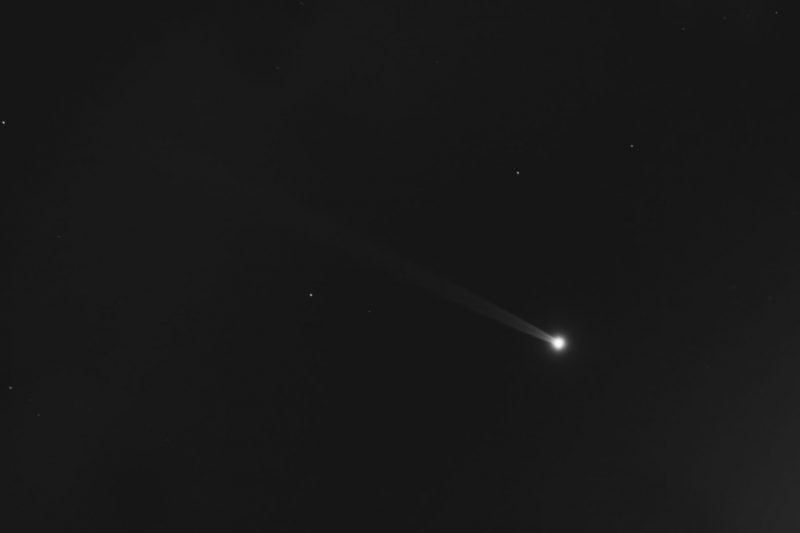
Sun activity for April 11, 2023: Meet AR3276
Sun activity is moderate, but we’ve seen action on the southeast limb (edge). A newcomer has been blasting flares, including yesterday’s M2.8 flare. Over the past day (11 UTC yesterday to 11 UTC today), AR3276 produced 10 C flares even before coming fully into view. Finally it was labeled; specialists need to have full view of an active region to assign a new number. In all (both not in view and in view), AR3276 was today’s leading flare producer with 17 C flares. So this is the guy to watch! In the meantime, two other new sunspots were labeled, too: AR3274, which emerged very near the point where the solar central meridian and equator meet, and AR3275 on the northeast quadrant. These two have been stable and present no relevant activity. Stay with us.
Last 24 hours: Sun activity is moderate. The sun produced 25 C class flares and one M flare during the period from 11 UTC yesterday to 11 UTC today. The largest was an M1.3, blasted by AR3272 at 10:16 UTC on April 11. After the M flare an R1 (minor) radio blackout was observed affecting an area over Africa. AR3276 was the leading flare producer during the past day, with 17 flares. There are five labeled active regions on the Earth-viewed side of the sun.
Sun activity for April 9, 2023: AR3272 getting larger, coronal hole vanishing
Earth’s geomagnetic field continues calm. And the Earth-facing side of the sun has just two sunspot regions, plus a vanishing coronal hole. AR3270 appears on the sun’s southwest limb (edge) and it is now departing. All eyes are turned to AR3272, which recently rotated into view in the sun’s southeast quadtrant. During the past day, AR3272 increased in size and in the number of spots maintaining its beta-gamma configuration. Flaring productivity also increased (detailed below). NOAA forecasters increased their analysis of chances for C flares from AR3272 to 95%, which is now moving into a geoeffective position. That is a place on the sun where any possible CMEs from this region might affect Earth and cause auroral displays. Meanwhile, the sun’s far side looks to be bringing more action on the northeast limb (edge). We observed a gorgeous giant prominence early today, and GOES-16 captured it beautifully (image below).
Last 24 hours: Sun activity is considered low, but C-flare production increased over the past day. There were 19 C flares. And 18 of them came from active region AR3272. The largest was a C9.1, just shy of an M flare, that exploded earlier today (6:08 UTC on April 9, 2023). There are only two labeled active regions on the Earth-facing side of the sun today, and one is departing.
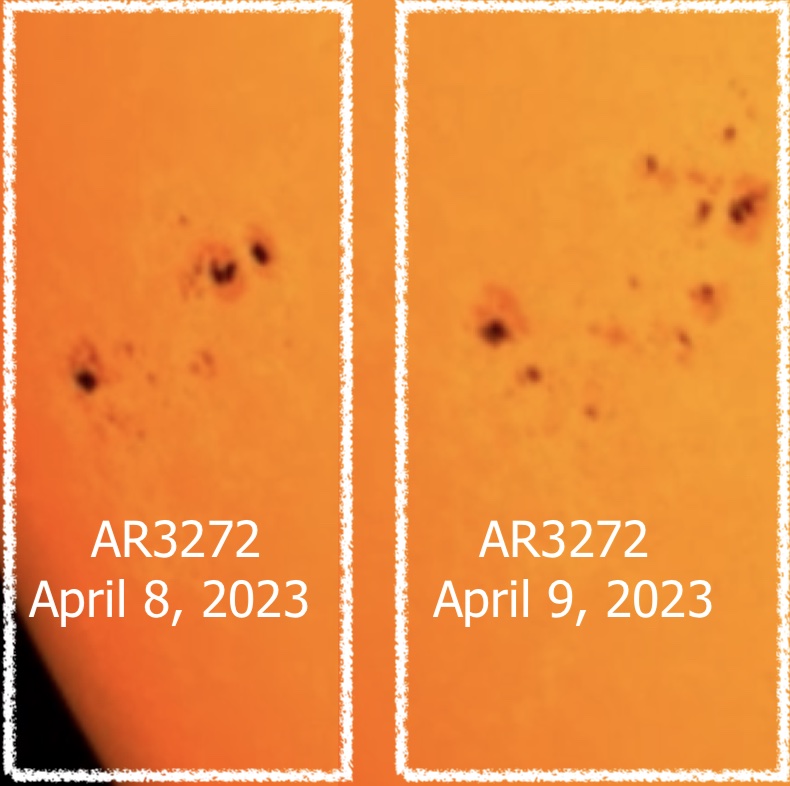
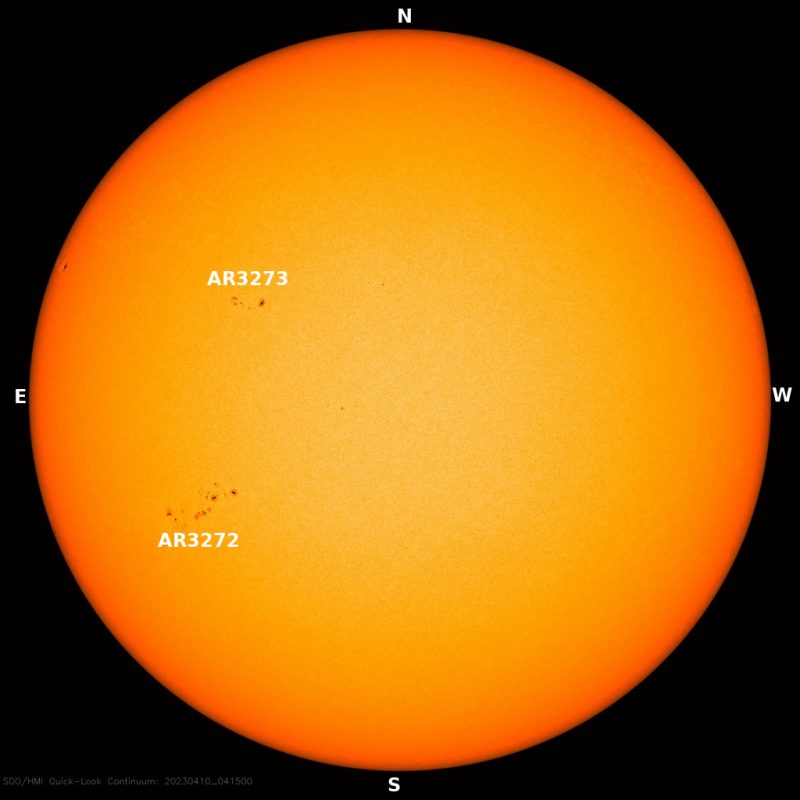
Sun activity for April 8, 2023: 13 Cs and an M, from 2 sunspots
A couple of days ago on April 6, an incoming active region on the sun’s southeast limb (edge) – still unnumbered at that time, as the sun’s rotation was carrying it into view – exploded with an M3.9 flare. Over the past day, this sunspot – now numbered AR3272 – gave us another M flare, plus a number of Cs. So sun activity is now considered moderate, despite the fact that there are only two visible spots on the Earth-facing side of the sun today. The M2.9 flare from AR3272 happened earlier today (details below). Before this M flare, we saw a strong C – a C5.8 – from the same region. Both flares looked beautiful, shining on the Earth-viewed solar disk. See our top animation, plus a zoomed-in version below. Meanwhile, at the other solar extreme – the southwest of the Earth-facing disk – yesterday’s hero AR3270 is about to be carried out of view. This region was calm and quiet over the past day, with a decayed penumbra and a beta configuration. If no other sunspot appears on the scene, after AR3270 leaves AR3272 will be the one to watch…and the only one! But you never know. Stay with us.
Last 24 hours: Sun activity climbed up to moderate with the M2.9 flare from AR3272 at 1:46 UTC on April 8. Shortly after the M flare, an R1 (minor) radio blackout was registered, affecting an area north of New Guinea on the Pacific Ocean. Over the past day (11 UTC yesterday to 11 UTC today) we saw 14 flares: 13 Cs and the M flare. AR3272 takes the lead in flaring production with 12 flares in the past day (the M flare included). There are only two labeled active regions on the Earth-facing side of the sun today.
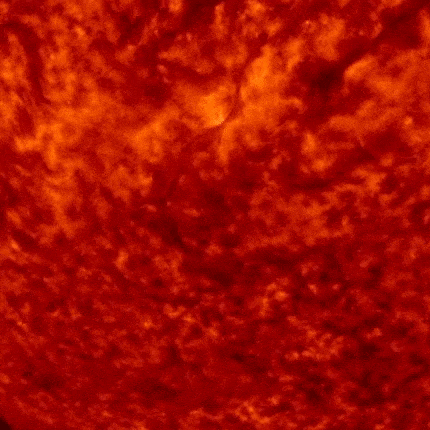
Sun activity for April 7, 2023: Huge blast from sun’s far side
Sun activity is back to low with only C-class flaring. But more action is coming our way from the sun’s far side. A huge prominence blasted from the sun’s southeast limb (edge), the side that’s now rotating into view. The blast took place at around 7 UTC on April 7 (see above animation). A coronal mass ejection (CME) can be seen, but it was not Earth-directed. Meanwhile, AR3270 – the active region we’ve followed for the past few days, which emerged abruptly, grew in magnetic complexity, then split into two – finally began to contribute flares. The largest flare of the past day exploded from it. It was a C3.9 at 14 UTC on April 6, with no CME. Now AR3270 is close to being carried out of sight by the sun’s rotation, on the southwest limb (edge). And AR3266 – in the northwest – is also leaving. No other significant events on the solar disk … for now. Stay tuned.
Last 24 hours: Sun activity is low. We saw 10 C flares in the past day (from 11 UTC yesterday to 11 UTC today). As explained above, the largest flare was a C3.9 blasted at 14 UTC on April 6 by AR3270. AR3272 continued to be the lead flare producer. It blasted out six C flares of the 10 flares across the day. The coronal hole we saw emerging in the sun’s northern hemisphere yesterday is now almost touching the sun’s central meridian: the north-south line crossing the center of the sun’s visible face. Soon, this coronal hole will be geoeffective – capable of affecting Earth – with its high-speed solar wind. There are four labeled active regions on the Earth-facing side of the sun today.
Sun activity for April 6, 2023: M flare!
Is sun activity picking up? One swallow does not make a summer, but this morning’s M flare pushes solar activity up to moderate. The sun has been quiet for several days. We haven’t seen an M flare since March 30. An as-of-yet unnumbered region on the sun’s southeast limb – just now rotating into view – was the source. Because it occurred just over the sun’s limb, or edge, the flare might have been larger than M3.01. Part of it was occulted (blocked) by the sun.
Last 24 hours: Sun activity is moderate. There were 11 C flares and one M in the past day. This single M flare occurred at 5:53 UTC from an unnumbered sunspot region on the southeast limb (edge). Shortly after the flare, an R1 (minor) radio blackout was observed, affecting an area over the Bay of Bengal in the Indian Ocean. Also, a coronal hole has emerged on the sun’s northeast quadrant. There are three labeled active regions on the Earth-facing side of the sun today.
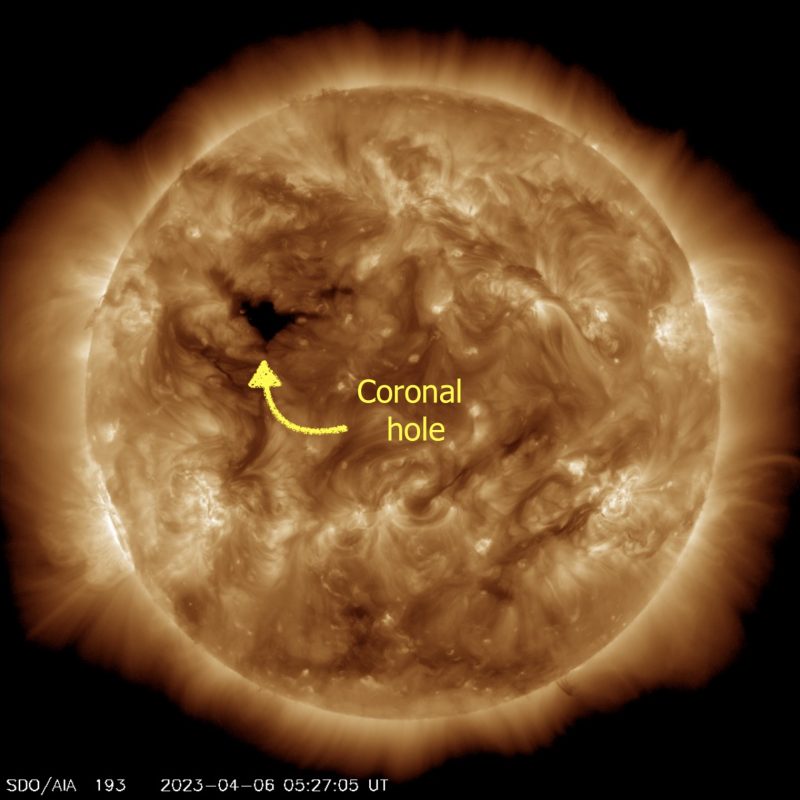
Sun activity for April 5, 2023: Potential X producer splits into two
Sun activity is low. And Earth’s geomagnetic field is also quiet. The large sunspot we mentioned yesterday – AR3270, which had appeared suddenly and grown quickly to a beta-gamma-delta configuration, indicating a potential for X flares – took a different direction during the past day. A second sunspot has now emerged close to AR3270. At first, this second sunspot was considered part of AR3270. But, during the past day, specialists considered it a separate sunspot region and numbered it AR3271. In the meantime, AR3270 started to simplify and lose its X flare potential. It lost its delta magnetic classification, for example. At this writing (11 UTC on April 5), AR3270 has decayed to a beta-gamma magnetic classification, while AR3271 has maintained an alpha configuration, the simplest. Along with the other two sunspots on Earth-facing regions, both AR3270 and AR3271 are stable with low flaring potential and production.
Last 24 hours: Sun activity is low. There was only one C flare in the past day. This single C flare from AR3270 barely crossed the B class threshold. It reached a C1.1 class at 3:29 UTC on April 5. There are four labeled active regions on the Earth-facing side of the sun today.
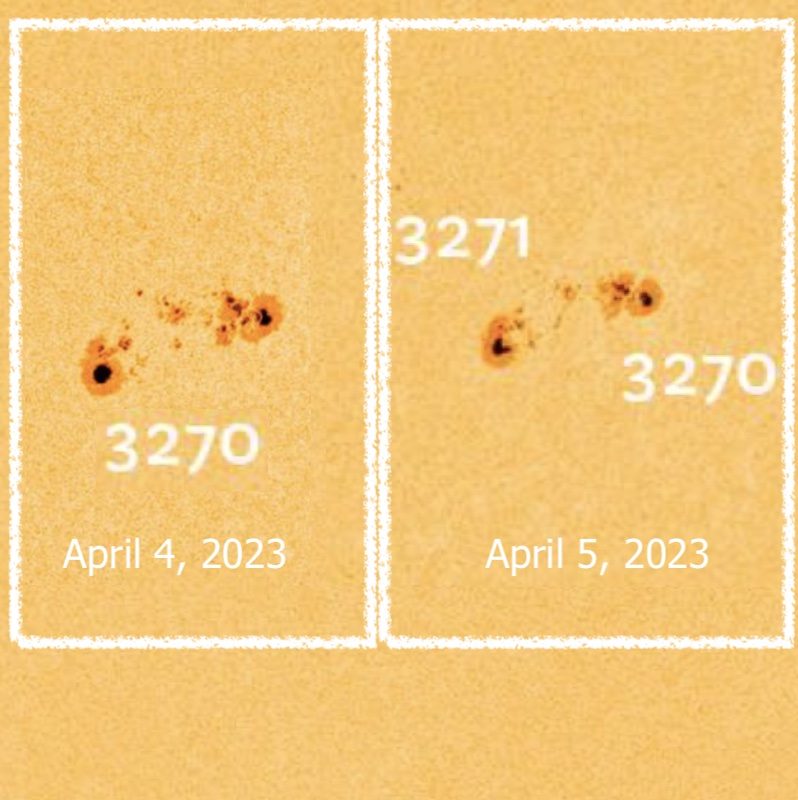
Sun activity for April 4, 2023: Is the new sunspot region an X producer?
Sun activity is low. But big activity could come soon. Sunspot region AR3270 emerged very quickly on April 2. Now it is about the area of Earth. It has also grown from a fairly simple region to one containing a delta region over the past day. The delta magnetic classification shows mixing in the magnetic fields indicative of stronger flaring activity. Its overall complexity is now classified as beta-gamma-delta, a strong sign of M and possibly X flares to come. Will this region give us a show and produce an X flare? We don’t know yet, but the potential is growing. Exciting! Stay tuned!
Last 24 hours: Sun activity is low. There were nine C flares. The largest event was a C2.8 flare at 23:53 UTC on April 3 from AR3270. There was a 12-hour gap of no significant flaring between 10:05 UTC and 22:17 UTC on April 3. AR3270 produced all the flares during the period. There are four labeled active regions on the Earth-facing side of the sun.
Sun activity for April 3, 2023: Here comes the sunspot
Sun activity is low, but has picked up since the previous 24 hours. This is due to a newly emerged sunspot region that seems to have come out of nowhere. The region began to appear near center of the sun’s Earth-facing disk around 9:30 UTC on April 2, 2023. The region looks much like an atoll in the middle of an ocean. This shape is probably because of the sunspot emerging along the edges of a giant bubble of solar material. Solar material bubbles to the surface in convection cells much like the bubbles in a pot of boiling water. The large-scale bubbles are called supergranulation cells. It’s fun to see the sunspot rise from below the sun’s visible surface or photosphere. Now we await what the region brings in terms of flaring. Since its emergence, it has produced three C flares. Will the flaring continue? Inquiring minds want to know. Stay tuned!
Last 24 hours: Sun activity is low with four C flares. The largest event was a C3.4 at 23:04 UTC, April 2, 2023 from the newly emerged region AR3270. Three of the four flares came from AR3270 and the other C flare came from the east limb (edge). There are four numbered active regions on the Earth-facing side of the sun.
Sun activity for April 2, 2023: A very quiet sun day
Sun activity is very low. The sun appears to be taking a little break for the weekend. Flaring has barely reached the C level with just one C1.0 flare. Yesterday, we saw several coronal mass ejections (CMEs) produced by filament eruptions but nothing heading our way. We don’t see any significant sunspot regions on the back side using helioseismology. Even the geomagnetic field is calm for now. Enjoy the calm knowing that the sun can and will continue to surprise us. We await the next flurry of activity with bated breath. Stay tuned!
Last 24 hours: Sun activity is very low with only a C1.0 flare at 8:03 UTC, April 2, 2023 from AR3260. There are three numbered active regions on the Earth-facing side of the sun.
Sun activity for April 1, 2023: Coronal mass ejections, none Earth-bound
Sun activity is low. But we saw gorgeous prominences all around the sun’s edges, particularly on the west or receding edge, both north and south. The prominences were accompanied by coronal mass ejections (CMEs), but none were Earth-directed. Take a look to our top animation: The second largest flare of the past day was a C6.8 flare by AR3257 at 3:28 UTC on April 1. The long-lasting prominence on the sun’s northwest limb – which we saw throughout yesterday – ended in beautiful ejecta. And on the southwest limb, fiery prominences blazed. The southwest prominences might be the output of the now-departed AR3256, which produced Wednesday’s X flare. But we can’t know for sure, as they came from the sun’s far side. But LASCO C2 and C3 captured the CMEs that they produced. Take a look at the animation below from LASCO C3. Be sure to watch for Jupiter’s entrance onto the scene! Jupiter will pass most directly behind the sun as seen from Earth on April 11.
Last 24 hours: Sun activity is low, in both flare production and intensity. Seven C flares and a faint B flare made a total of only eight flares between 11 UTC March 31 and 11 UTC April 1. The largest was an impulsive C9.7 flare, almost reaching the threshold of an M flare. It was produced at 20:57 UTC on March 31 by AR3257, which has now decayed to plage. There are four numbered active regions on the Earth-viewed side of our sun today.
Bottom line: Sun activity archive for April 2023. A daily record of flaring, big filaments and prominences, and other sorts of activity, on our local star.











